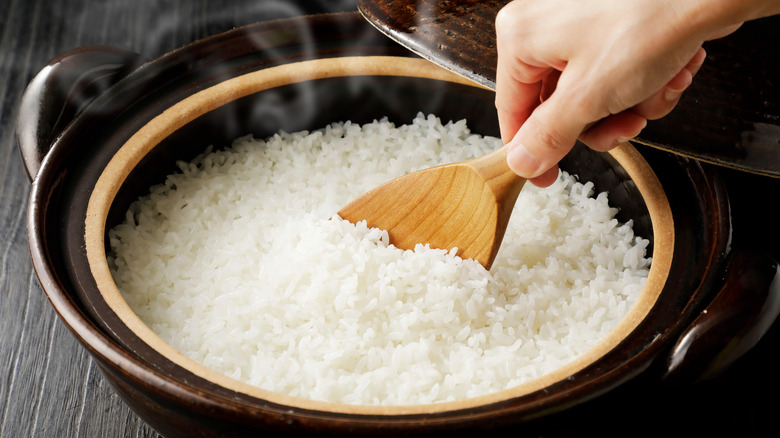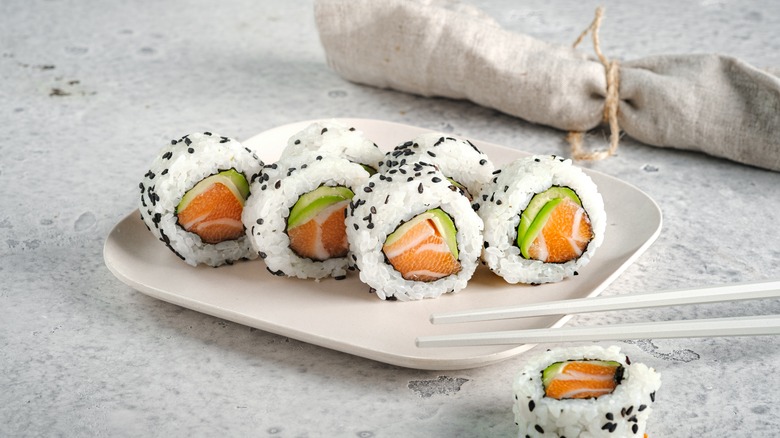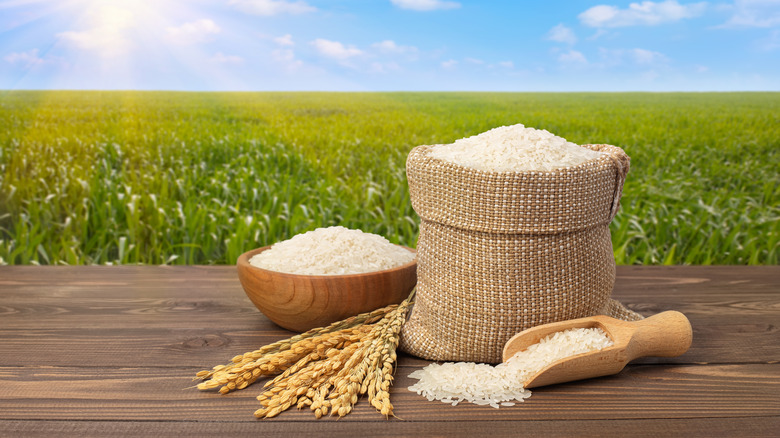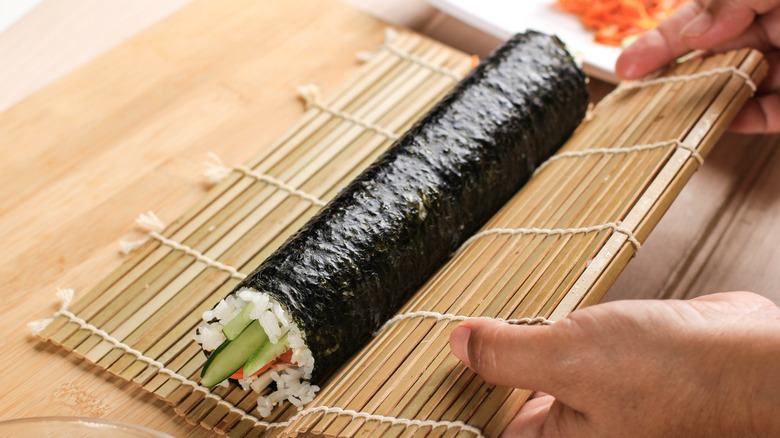If You're In The US, The Rice In Your Sushi Likely Came From These States
Did you know that September is National Rice Month in the U.S.? Rice (Oryza sativa) is a grain that plays a big role in sushi, but it also plays a big role in the U.S. economy. According to Think Rice, U.S. farmers grow 20 billion pounds of this grain each year. That subsector of the agriculture industry also provides nearly $35 billion to the national economy on an annual basis, and donates millions of pounds of rice to those in need.
Rice cultivation in the U.S. helps out abroad, as well. The country as a whole is the fifth biggest global exporter of rice, per the same source. Perhaps unsurprisingly, given rice's historical roots, only Asian countries have the U.S. beat in terms of exports. Maybe Americans are coming in fifth simply because they love rice so much and are keeping a lot of their crop for themselves.
That's not a bad thing, either, given that rice from the U.S. is hypoallergenic and has no cholesterol, gluten, or sodium (via Think Rice). It also possesses plenty of fiber, minerals, and vitamins, making it fairly healthy for American consumers. Not all rice is the same, though. White rice is but one of many categories, and even within that group, sushi rice stands out.
What is sushi rice?
You can't use just any rice for sushi. When you're creating a base for raw fish or rolling it up, you're going to want good construction material. That's where sushi rice comes in: high-quality medium or short grains, often combined with flavorful liquids under heat. The result is something mouthwatering and sturdy, yet malleable. Japan has its own sushi rice — Uruchimai, which is rather short — but the U.S. tends to grow the Calrose strain, per the All About Sushi Guide.
Japanese Americans developed this medium-type grain on the West Coast in the middle of the 20th century. Nowadays, household-name grocery stores stock the Kokuho Rose and Nishiki varieties of Calrose for those looking to make Japanese dishes. If you're searching for top-shelf stuff, keep an eye out for Tamaki Gold and Tamanishiki, both of which are from California. Although, you may have to go to a specialty Asian store for those unique types. Even Koshihikari — arguably Japan's favorite variety — is now being cultivated in the U.S., so you may even find that at your local shop, too!
Where US sushi rice is grown
Unlike other grains, rice plants like lots of clay, loam, and silt, and since they're semi-aquatic, they need water at basically all times (via Think Rice). Crops are planted in spring with the use of precise technologies. Then, they take a third of the year to grow between roughly 3 to 4 feet in height. In late summer and throughout fall, the farms drain their rice paddies and cut the stalks to collect their grain before drying them for storage. The final process prior to hitting the market shelf is milling, where the hulls are removed. For white rice, the grain is polished and supplemental vitamins are added.
Almost 6,000 rice growers exist across the U.S., taking up nearly 3 million acres of land (via Think Rice). This cultivation is mainly done within a handful of states: Arkansas, California, Louisiana, Mississippi, Missouri, and Texas. If you're in the U.S., the rice in your sushi likely came from one of these states. Domestically cultivated rice accounts for 80% of all rice eaten across the country, and 95% of sushi uses it. When it comes to sushi rice in particular, California grows the vast majority of it. 85% of U.S. sushi rice was California-grown as recently as 2018, per the Sacramento Bee. Harvesting happens in autumn, but don't worry if you're buying rice in the off-season; rice stays fresh for up to a year or more (via All About Sushi Guide).
How to use sushi rice
Sushi rice is mostly used for — you guessed it — sushi. Whether you're rolling it, filling up a hand roll, or laying fresh fish down in bowl of rice, it's the go-to ingredient. Its simple-yet-appetizing appearance is great for presentation, and its stickiness makes it ideal for holding things together. According to Plant Based FAQs, this is because of its levels of amylopectin, a starch that makes it gelatinous once rice is cooked with water. Adding salt, sugar, and vinegar to sushi rice after preparing it can also help elevate it from mild in taste to delicious in flavor.
Don't discount it for use in other types of dishes, though. Despite the specificity in its name, sushi rice can also be used in flour, mochi, and sake. A California roll might be the most fitting thing to make with it, though, given the high likelihood your American sushi rice came from that exact state. Next time you're biting into a rainbow roll, imagine a rainbow arcing over a lush West Coast rice paddy. Hopefully, knowing where the stuff came from will make you appreciate it much more.



